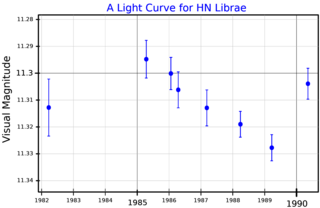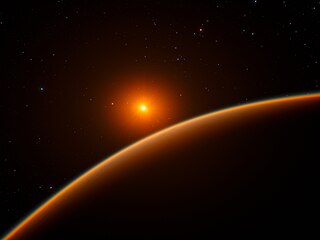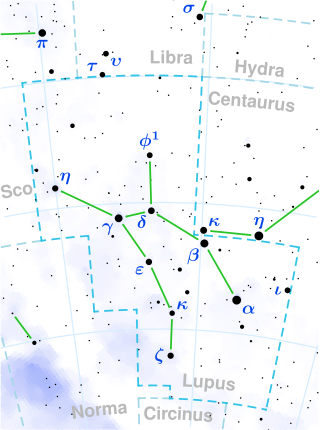Gliese 1061 is a red dwarf star located approximately 12 light-years from Earth in the southern constellation of Horologium. Even though it is a relatively nearby star, it has an apparent visual magnitude of about 13, so it can only be seen with at least a moderately-sized telescope.
Luyten's Star (GJ 273) is a red dwarf in the constellation Canis Minor located at a distance of approximately 12.35 light-years from the Sun. It has a visual magnitude of 9.9, making it too faint to be viewed with the unaided eye. It is named after Willem Jacob Luyten, who, in collaboration with Edwin G. Ebbighausen, first determined its high proper motion in 1935. The star has two confirmed planets and two candidate planets, of which Luyten b is in the circumstellar habitable zone.
Gliese 1 is a red dwarf in the constellation Sculptor, which is found in the southern celestial hemisphere. It is one of the closest stars to the Sun, at a distance of 14.2 light years. Because of its proximity to the Earth it is a frequent object of study and much is known about its physical properties and composition. However, with an apparent magnitude of about 8.6 it is too faint to be seen with the naked eye.
Gliese 674(GJ 674) is a small red dwarf star with an exoplanetary companion in the southern constellation of Ara. It is too faint to be visible to the naked eye, having an apparent visual magnitude of 9.38 and an absolute magnitude of 11.09. The system is located at a distance of 14.8 light-years from the Sun based on parallax measurements, but is drifting closer with a radial velocity of −2.9 km/s. It is a candidate member of the 200 million year old Castor stream of co-moving stars.

Gliese 105 is a triple star system in the constellation of Cetus. It is located relatively near the Sun at a distance of 23.6 light-years. Despite this, even the brightest component is barely visible with the unaided eye (see Bortle scale). No planets have yet been detected around any of the stars in this system.

Stein 2051 is a nearby binary star system, containing a red dwarf and a degenerate star, located in constellation Camelopardalis at about 18 ly from Earth.
Gliese 1062 is a single red dwarf star in the constellation Eridanus, positioned about two degrees to the SSE of Epsilon Eridani. It is also known as LHS 20 and Ross 578. The star is invisible to the naked eye with an apparent visual magnitude of +13.0, requiring a telescope with at least a 25 cm (10 in) aperture to view. It is located at a distance of 52.7 light years from the Sun based on parallax, but is drifting closer with a radial velocity of −85 km/s. The star has a high proper motion, traversing the sky at the rate of 3.033 arcseconds per year.

Gliese 180, is a small red dwarf star in the equatorial constellation of Eridanus. It is invisible to the naked eye with an apparent visual magnitude of 10.9. The star is located at a distance of 39 light years from the Sun based on parallax, and is drifting closer with a radial velocity of −14.6 km/s. It has a high proper motion, traversing the sky at the rate of 0.765 arcseconds per year.
Gliese 3323 is a nearby single star located in the equatorial constellation Eridanus, about 0.4° to the northwest of the naked eye star Psi Eridani. It is invisible to the naked eye with an apparent visual magnitude 12.20. Parallax measurements give a distance estimate of 17.5 light years from the Sun. It is drifting further away with a radial velocity of +42.3 km/s. Roughly 104,000 years ago, the star is believed to have come to within 7.34 ± 0.16 light-years of the Solar System.
Gliese 205 is a nearby red dwarf star of spectral type M1.5, located in constellation Orion at 18.6 light-years from Earth.
LP 816-60 is a single red dwarf star of spectral type M4, located in constellation Capricornus at 18.6 light-years from Earth.
Gliese 693 is a red dwarf star and a flare star of spectral type M2 located in the constellation Pavo, 18.95 light-years from Earth.

Gliese 908 is a red dwarf star, located in constellation Pisces at 19.3 light-years from Earth. It is a BY Draconis variable star with a variable star designation of BR Piscium. Its apparent magnitude varies between magnitude 8.93 and magnitude 9.03 as a result of starspots and varying chromospheric activity.
Gliese 784 is a single red dwarf star located in the southern constellation of Telescopium that may host an exoplanetary companion. The star was catalogued in 1900, when it was included in the Cordoba Durchmusterung (CD) by John M. Thome with the designation CD -45 13677. It is too faint to be viewed with the naked eye, having an apparent visual magnitude of 7.96. Gliese 784 is located at a distance of 20.1 light-years from the Sun as determined from parallax measurements, and is drifting closer with a radial velocity of −33.5 km/s. The system is predicted to come as close as 11.4 light-years in ~121,700 years time.

Gliese 555 is a red dwarf star of spectral type M4.0V, located in constellation Libra at 20.2 light-years from Earth.
GJ 1128 is a red dwarf star of spectral type M4.0V, located in constellation Carina 21 light-years away from Earth. It is one of the closer stars to the Sun.

LHS 1140 is a red dwarf in the constellation of Cetus. Based on its stellar properties, it is thought to be about 41 light-years away from the Sun. 'LHS' refers to the Luyten Half-Second Catalogue of stars with proper motions exceeding half a second of arc annually. The star is over 5 billion years old and has only about 18% the mass of the Sun and 21% of its radius. LHS 1140's rotational period is 130 days. No flares have been observed.
Gliese 877 is a red dwarf located in the southern constellation of Octans, near the boundary with Indus.
Gliese 686 is a star in the constellation of Hercules, with an apparent magnitude +9.577. Although it is close to the Solar System - at 26.5 light years - it is not the closest known star in its constellation, since Gliese 661 is 20.9 light years away. The closest system to this star is the bright μ Herculis, at 4.5 light years. They are followed by GJ 1230 and Gliese 673, at 7.2 and 7.6 light years respectively.






